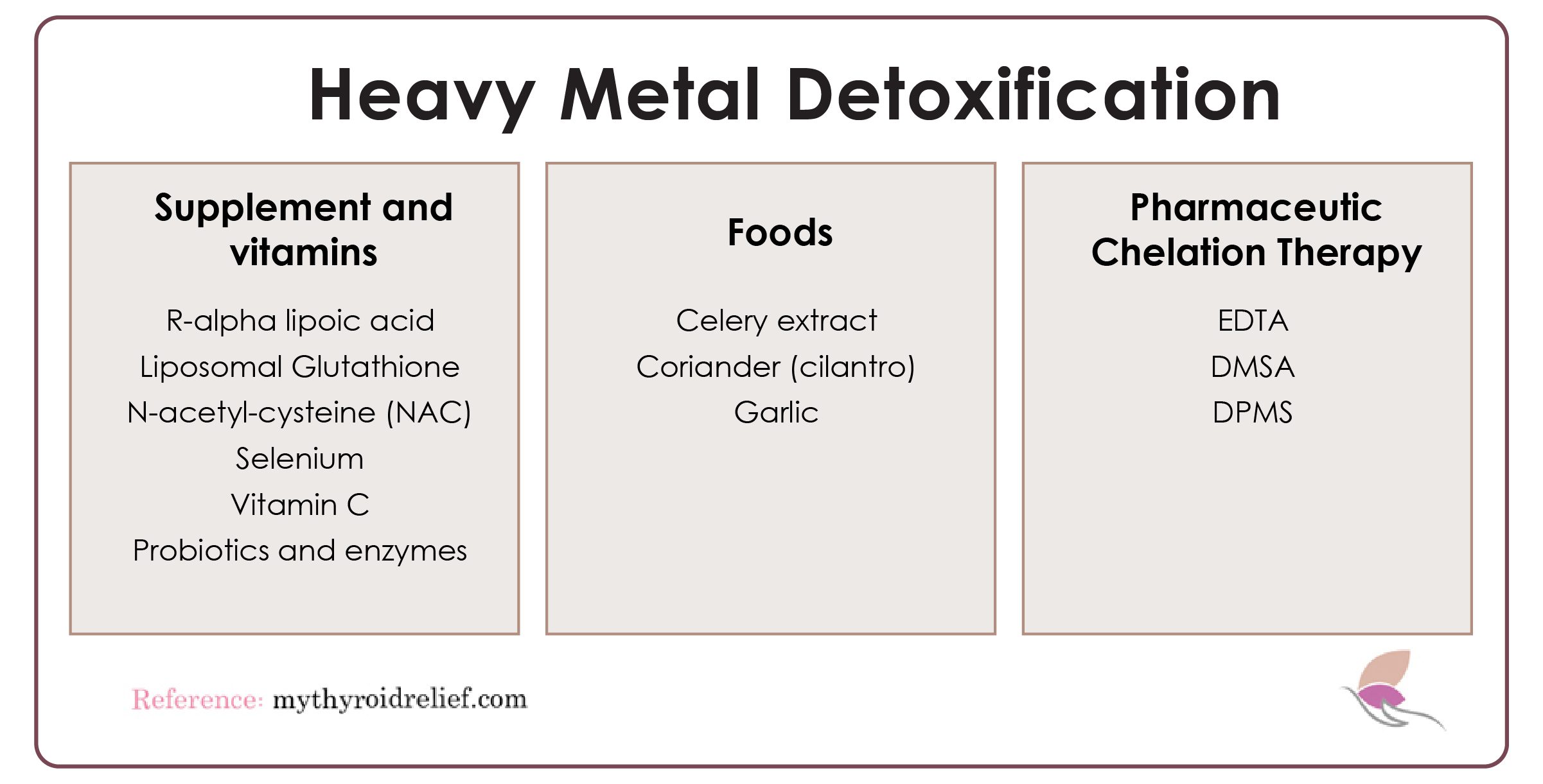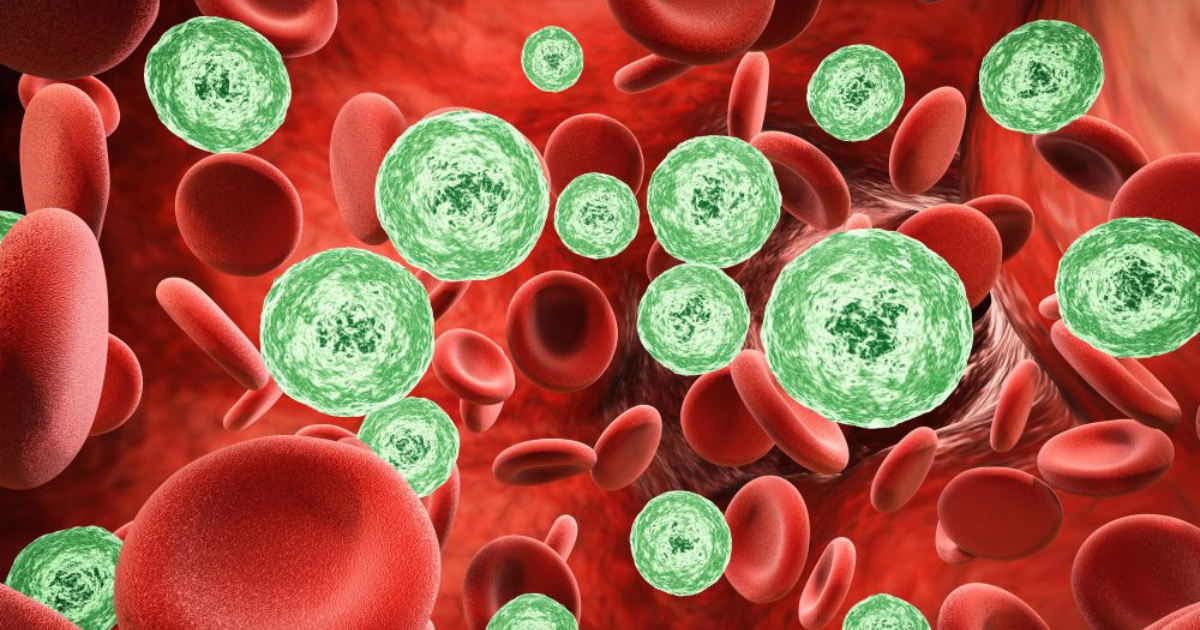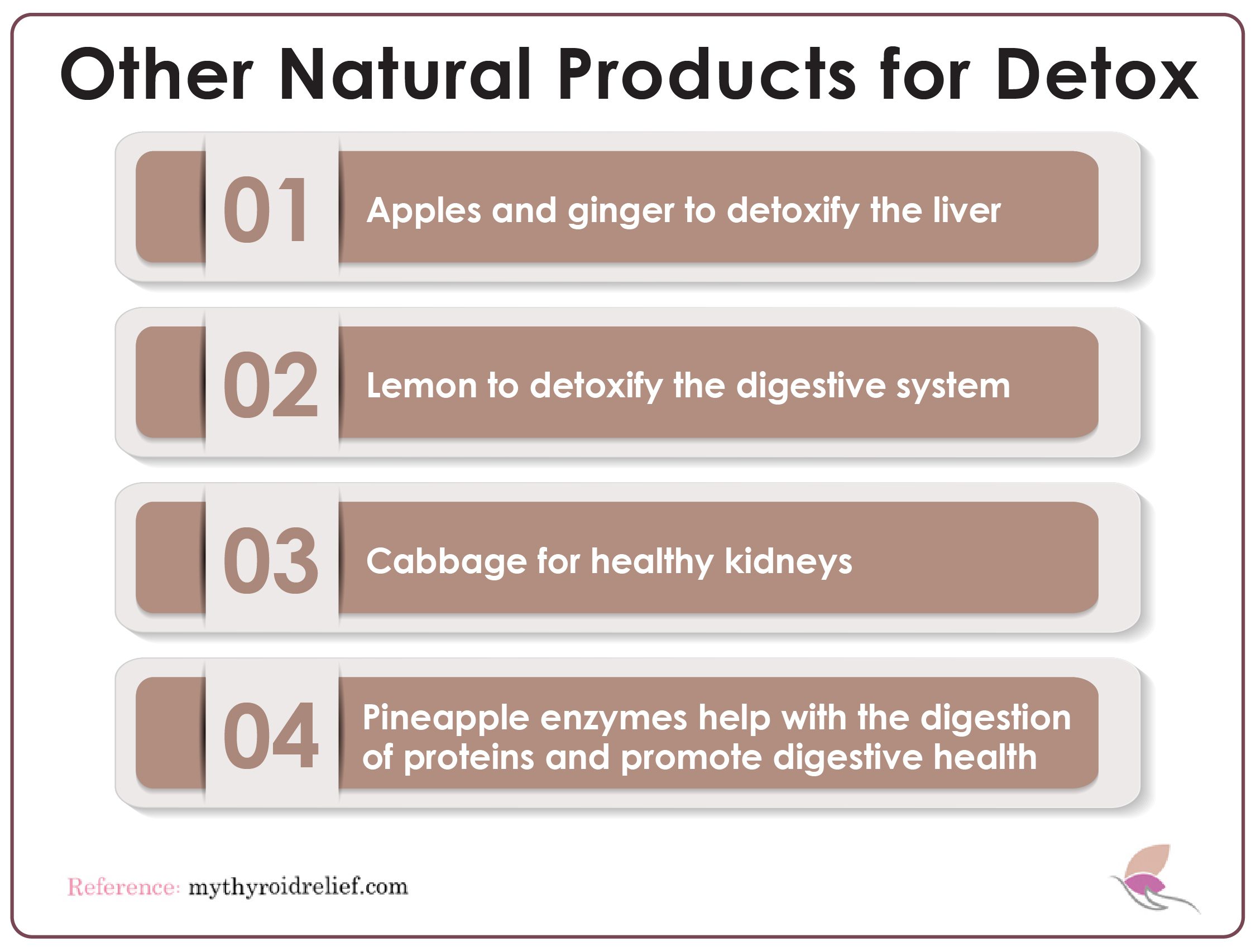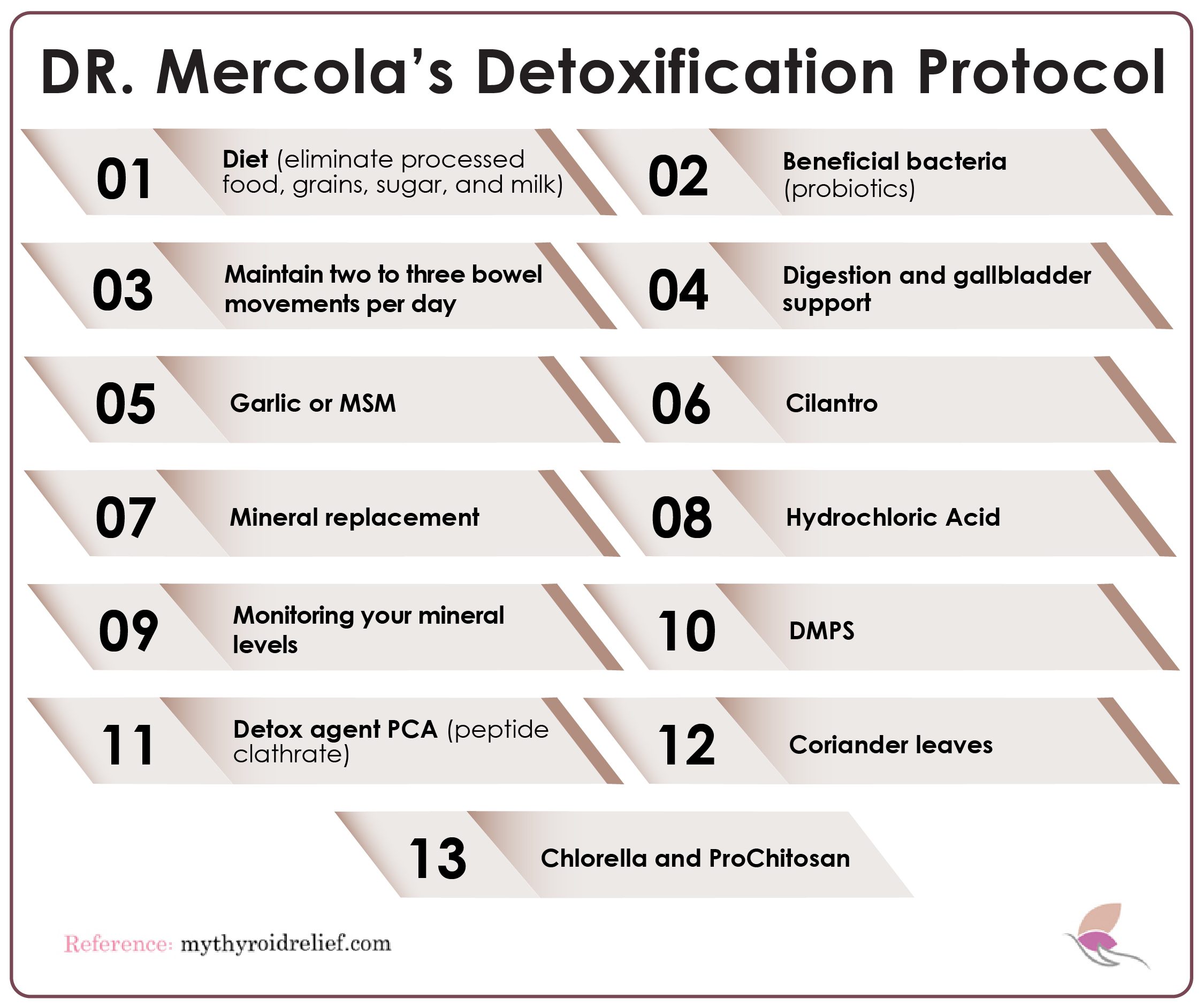
Heavy metal toxicity poses serious risks to organs such as the brain, liver, and lungs by disrupting cellular function and energy metabolism. Accumulated heavy metals can alter blood composition and lower overall energy levels. Regular exposure to low levels of heavy metals can lead to severe health complications over time, emphasizing the importance of detoxification strategies to eliminate these toxins from the body. The thyroid gland, which regulates metabolism and hormone balance, is particularly vulnerable to heavy metal toxicity. Heavy metals can interfere with thyroid hormone production and disrupt its delicate balance, potentially causing thyroid disorders and related health issues.
As these heavy metals build up, they affect thyroid function, weaken the immune system, harm neurological health, and impact cardiovascular stability. Given the widespread exposure to heavy metals in today’s environment, effective detoxification strategies are crucial for maintaining thyroid health and overall well-being. Detoxifying the body from accumulated heavy metals supports thyroid function and enhances energy levels, cognitive function, and immune resilience.

Alpha-Lipoic Acid in Detoxification and Thyroid Support
Alpha-lipoic acid, a natural substance found in every cell, plays crucial roles in carbohydrate breakdown, energy production, and antioxidant defense. It helps protect against cellular damage and supports the regeneration of vitamins like E and C. Research indicates it can effectively chelate heavy metals such as lead and mercury, though caution is advised in cases involving dental amalgams to prevent metal redistribution. It’s advisable to consult with healthcare professionals, especially dentists trained in safe amalgam removal protocols, to minimize risks associated with heavy metal exposure.
Alpha-lipoic acid may effectively reduce high cholesterol levels and other fats (lipids) in the blood, a condition known as hyperlipidemia. Studies indicate that taking alpha-lipoic acid for up to four years can lower total cholesterol and low-density lipoprotein (LDL) cholesterol. Also, some research suggests that alpha-lipoic acid can slightly reduce body weight in overweight adults when taken for periods ranging from 2 to 48 weeks. Although our bodies produce alpha-lipoic acid naturally, it can also be found in various foods, including asparagus, beets, broccoli, brussels sprouts, carrots, red meat, and organ meats.
Exploring Alpha-Lipoic Acid’s Role in Thyroid Eye Disease
Thyroid eye disease, a condition often associated with Graves’ disease, involves inflammation and tissue remodeling around the eyes. This can lead to symptoms such as bulging eyes, discomfort, and vision problems. Alpha-lipoic acid has emerged as a potential therapeutic agent for managing this condition. A study published in the journal Medicine (Baltimore) demonstrated that alpha-lipoic acid significantly reduced the production of reactive oxygen species (ROS), which are harmful molecules that contribute to cellular damage. Additionally, the study found that alpha-lipoic acid decreased levels of proinflammatory cytokines, including tumor necrosis factor-alpha (TNF-α), which plays a crucial role in the inflammatory processes associated with thyroid eye disease.
Beyond its antioxidant and anti-inflammatory properties, alpha-lipoic acid may help protect the delicate tissues around the eyes from further damage. Its ability to enhance mitochondrial function and energy metabolism in cells adds another layer of protection, potentially slowing the progression of the disease and improving overall eye health. Given these promising findings, further research and clinical trials are warranted to fully establish the efficacy of alpha-lipoic acid as a treatment for thyroid eye disease.
Comparing Alpha-Lipoic Acid and R-Alpha Lipoic Acid
Alpha-lipoic acid (ALA) exists in two forms: R-alpha-lipoic acid (R-ALA) and S-alpha-lipoic acid (S-ALA). The R form is the naturally occurring form produced in the body, whereas the S form is a synthetic byproduct created during manufacturing. Alpha-lipoic acid supplements usually contain a mixture of R-ALA and S-ALA, known as DL-alpha-lipoic acid.
R-alpha-lipoic acid is the biologically active form of lipoic acid, meaning it is the form that the body can most readily utilize. This is because R-ALA is identical to the lipoic acid molecules naturally found in the body’s cells. Inside the cells, alpha-lipoic acid plays a critical role in mitochondrial function, where it helps to convert glucose into energy. This process is essential for cellular activity and fuel synthesis, providing the necessary energy for various biochemical reactions within the body.
The differences between R-ALA and S-ALA also extend to their bioavailability and effectiveness. Research has shown that R-ALA is more efficiently absorbed and utilized by the body than its synthetic counterpart. This higher bioavailability means that R-ALA can exert its antioxidant effects more effectively, scavenging free radicals and reducing oxidative stress. As a result, supplements containing only R-ALA may offer more potent health benefits than those containing the mixed DL-ALA form.
Moreover, studies suggest that R-ALA can enhance insulin sensitivity, support healthy blood sugar levels, and promote nerve health more effectively than the DL-ALA form. This makes R-ALA particularly beneficial for individuals with conditions such as diabetes or peripheral neuropathy. While both forms of alpha-lipoic acid have health benefits, R-alpha-lipoic acid is the superior choice due to its natural occurrence, higher bioavailability, and greater effectiveness in supporting cellular energy production and antioxidant defenses.
Glutathione and Its Role in Detoxification
Glutathione is a crucial antioxidant and detoxifier naturally produced by the body to combat oxidative stress and remove harmful toxins, including heavy metals. It plays a pivotal role in cellular detoxification processes, binding to heavy metals and facilitating their excretion through bile and urine. However, glutathione levels decline with age and exposure to environmental stressors, compromising its detoxification capabilities. Supplementation with precursors like N-acetylcysteine (NAC) or direct glutathione supplements, particularly in its liposomal form for better absorption and bioavailability, may help replenish depleted levels and support ongoing detoxification binding heavy metals and facilitating their excretion.
Chronic inflammation and oxidative stress can deplete glutathione stores, making individuals more susceptible to heavy metal toxicity. Lifestyle factors such as poor diet, chronic infections, and environmental toxins further exacerbate glutathione depletion. Excessive alcohol use, food intolerance, sleep deprivation, and hormonal or immunological imbalances are all glutathione-depleting stressors that must be removed or alleviated to enhance glutathione status.
Maintaining optimal glutathione levels through dietary modifications, supplementation, and lifestyle changes is essential for effective detoxification and overall health. By supporting general detoxification functions, glutathione acts as a natural chelator for heavy metals and environmental pollutants, promoting healthy immune function and protecting against various chronic health issues.
Vitamin C for Thyroid and Overall Health

Celery and Its Detoxifying Properties

Celery is a vegetable rich in organic compounds and salts, which play a significant role in deacidifying the blood. It is known for eliminating harmful bacteria and fungi in the urinary tract, kidneys, intestines, and stomach. Additionally, celery is a source of B vitamins, including vitamin B12, which increases concentration and stress relief.
Celery improves lower abdominal blood circulation, enabling heavy metals and harmful chemicals accumulated in the abdominal cavity to enter the bloodstream more effectively. This process enhances the body’s overall detoxification. The healing effects of celery are most potent when consumed raw, so it is recommended to buy organic celery. According to the Environmental Working Group (EWG), almost 95 percent of celery samples contain pesticide residues, as reported in their 2021 study.
Celery juice has numerous benefits, including supporting thyroid health, reducing chronic inflammation, and improving hydration. However, it should not replace professional medical treatment for thyroid conditions. While celery juice aids in detoxification, it does not cleanse the body on its own. The human body has a complex detoxification system involving the liver, kidneys, intestines, and lungs. Therefore, consuming celery juice and maintaining a healthy lifestyle is essential for optimal detoxification and overall health. Incorporating celery into your diet, particularly as juice, can enhance detoxification processes and support overall well-being. However, combining this with other healthy habits and dietary choices is crucial to achieve the best results.
The Three Most Important Questions About Celery Juice
Anthony William, the originator of the celery juice diet, provides insights in his book, “Medical Medium Celery Juice.” Here are three essential questions about celery juice:
- How much celery juice should we consume to feel its healing effect?
- Half a liter of pure celery juice daily is sufficient to experience its healing benefits.
- Is it possible to eat celery instead of drinking celery juice?
- To fully benefit from celery’s remarkable curative effects on chronic ailments, it is better to drink the juice rather than eat the whole vegetable. Juicing removes the fibrous pulp, which can hinder the unique healing properties of celery juice.
- Can celery powder be used instead of fresh celery?
- No, celery powder cannot replace celery juice. It lacks the same anti-inflammatory properties as half a liter of freshly squeezed celery juice.
Chelation Therapy for Heavy Metal Detox

Chelation therapy is a medical procedure designed to remove toxic heavy metals from the body using chelating agents such as EDTA (ethylene diamine tetraacetic acid) or DMSA (dimercaptosuccinic acid). These agents bind to heavy metals in the bloodstream, forming complexes that are then excreted through urine. Chelation therapy is typically used for individuals with high levels of heavy metals, such as lead or mercury, resulting from occupational exposure or environmental contamination.
While chelation therapy can effectively reduce the heavy metal burden, it has risks. Chelating agents can also bind to essential minerals like calcium and zinc, leading to potential deficiencies if not properly monitored. Moreover, the procedure should be conducted under the supervision of qualified healthcare professionals to minimize side effects and ensure safety.
When individuals have dental amalgams containing mercury, precautions must be taken to prevent further exposure and manage potential risks associated with heavy metal redistribution during and after therapy. Before undergoing chelation therapy, comprehensive testing for heavy metal levels and consultation with healthcare providers are essential to tailor treatment strategies and mitigate potential risks.
Infrared Therapy as a Detoxification Method
Infrared therapy utilizes infrared light to penetrate deeply into tissues, stimulating detoxification by promoting circulation and increasing core body temperature. This heat-induced process helps release stored toxins, including heavy metals, from fat cells and tissues, which are then expelled through sweat and urine. Unlike UV radiation from sunlight, infrared therapy poses minimal risks to the skin while offering profound detoxification benefits.
The therapeutic effects of infrared therapy extend beyond detoxification, supporting cardiovascular health, immune function, and overall well-being. By enhancing blood flow and oxygenation, infrared therapy accelerates cellular metabolism and promotes tissue repair, making it a valuable adjunctive therapy for individuals seeking natural detoxification methods.
Regular infrared therapy sessions can complement dietary and lifestyle modifications aimed at reducing heavy metal burden and improving thyroid function. Its non-invasive nature and ability to enhance systemic detoxification make infrared therapy a preferred choice for individuals looking to support their body’s natural detoxification processes without the use of pharmaceuticals or invasive procedures.
EDTA and Heavy Metal Detoxification
EDTA can remove both necessary minerals and harmful metals from the body. Add vitamins and minerals to the EDTA solution to help the body function optimally. “The FDA has licensed calcium disodium EDTA for use in lead poisoning, and it has been the standard treatment for pediatric lead poisoning since the 1950s” (source: Science Direct). However, calcium EDTA’s hazardous effects necessitate careful monitoring of its administration, as the kidney is the most significant area of concern. Side effects in the treatment of lead poisoning include myalgia, nausea, a febrile reaction with headache, and vomiting.
Methylation
Methylation is a biological process that converts hazardous metals into methyl compounds, which are then released through volatilization. This process is critical for the proper functioning of almost all body systems. When your body experiences stress and needs extra help eliminating toxins and heavy metals, your liver struggles to keep up, making you vulnerable to these toxic compounds. Methylation converts B vitamins into S-adenosylmethionine (SAM-e) and glutathione, which are vital for health and help conserve our genes by keeping DNA wound up in histones. Toxic metals prevent DNA from being methylated, leaving our genes vulnerable, a process known as epigenetic modification.
Joseph Mercola is an osteopathic physician whose primary goal is to disrupt the existing health paradigm and empower people to take charge of their health.
OTHER NATURAL PRODUCTS FOR DETOX
- Diet: Eat healthy vegetables and fruits, such as apples, ginger, lemon, cabbage, and pineapple, to support the liver, kidney, and digestive health.
- Hydration: Drink plenty of water to help flush out toxins. Regular consumption of vegetable and fruit juices, which are rich in nutrients, can help maintain balance.
- Infrared Therapy: This method helps eliminate toxins through sweat by raising the body’s core temperature and improving blood circulation.

Testing for Heavy Metals
Testing for heavy metals involves analyzing blood, hair, or urine samples to assess metal levels and diagnose potential toxicity. Common metals tested include lead, mercury, arsenic, and cadmium, which can accumulate in the body due to environmental exposures or occupational hazards. Heavy metal panel testing helps identify sources of exposure and guide appropriate treatment strategies tailored to individual needs.
Heavy metal testing serves various purposes, including screening individuals with suspected exposure to toxic metals, diagnosing symptoms associated with heavy metal toxicity, and monitoring treatment efficacy in managing metal burden. Healthcare providers can develop personalized detoxification protocols and preventive measures to reduce ongoing exposure risks by identifying specific metals and their concentrations.
Comprehensive heavy metal testing is essential for individuals seeking to optimize thyroid function and overall health by addressing underlying environmental exposures and toxic burdens. Integrating test results with targeted interventions, such as nutritional support, detoxification therapies, and lifestyle modifications, empowers individuals to take proactive steps in safeguarding their health against heavy metal toxicity. Heavy metals can be measured individually or as part of a panel testing multiple compounds. The most common heavy metals panel includes testing for lead, mercury, arsenic, cadmium, copper, zinc, chromium, thallium, aluminum, beryllium, cobalt, iron, bismuth, manganese, nickel, silver, selenium, silicon, and platinum.
References
Heavy Metal Poisoning: https://www.webmd.com/a-to-z-guides/what-is-heavy-metal-poisoning
Alpha-Lipoic Acid: Everything You Need to Know: https://www.webmd.com/diet/alpha-lipoic-acid-ala
Glutathione: What You Should Know: https://www.webmd.com/vitamins-and-supplements/glutathione-uses-risks
Vitamin C: The Nutrition Source: https://nutritionsource.hsph.harvard.edu/vitamin-c/
Health benefits and risks of celery: https://www.medicalnewstoday.com/articles/270678
Heavy Metals Testing: https://labtestsonline.org.uk/tests/heavy-metals
Chelation Therapy: https://www.sciencedirect.com/topics/medicine-and-dentistry/chelation-therapy
Medical Medium Celery Juice by Anthony Williams: https://www.medicalmedium.com/medical-medium-celery-juice-movement
Mercury Detoxification Protocol by Dr. Joseph Mercola: https://www.mercola.com/article/mercury/detox_protocol.htm
